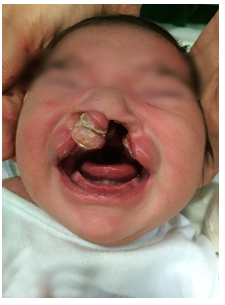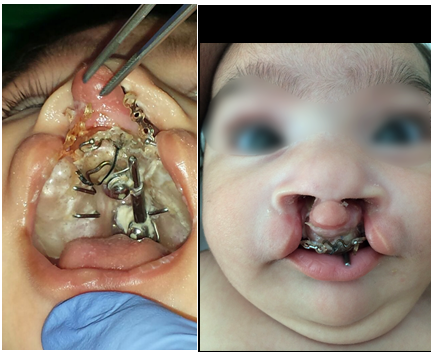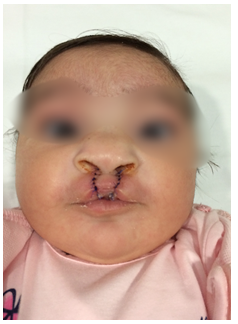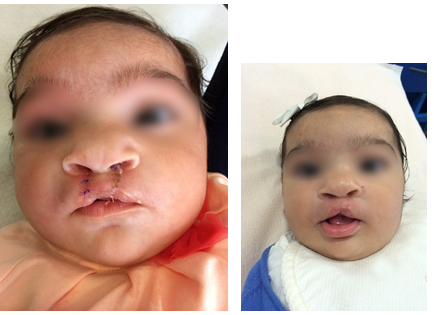Treatment of Bilateral Cleft Lip with Protruding Premaxilla: Therapeutic Alternatives
- 1. Departament of Pediatric Surgery, Hospital Teresa Herrera, Complejo Hospitalario Universitario de A Coruña, Spain
Abstract
The bilateral cleft lip is a complex anomaly whose repair presents a challenge for the surgeon. Multiple techniques have been described for treatment of bilateral cleft. The surgical approach and timing of repair can be debated; both of them are still subject of controversial.
We must add to the deformities presents in unilateral cases other changes in bilateral cleft as the absence of prolabium, deformity of nasal cartilage, a short columella, the collapse of the maxillary arcades and the protrusion of the premaxilla.
We must do correction of the protuding premaxilla previus to definitive treatment. There are multiple techniques among which we highlight the nasoalveolar molded and surgical adhesive technique. The use or not of pre-lip closure orthopedic treatments, as an alternative to the labial adhesion is one of the most contentious issues in the treatment of cleft children. In our center we have used both techniques with excellent results, we applied presurgical orthopedics as a precursor to the subsequent adhesion in selected cases with great protrusion of the premaxilla and extreme rotations.
Keywords
• Bilateral cleft lip
• Presurgical orthopedic treatment
• Premaxilla protrusion
Citation
Míguez FL, García GM, Caramés BJ (2017) Treatment of Bilateral Cleft Lip with Protruding Premaxilla: Therapeutic Alternatives. JSM Oro Facial Surg 2(1): 1004.
INTRODUCTION
The cleft lip and palate is the most common congenital malformation of the facial birth defects. There is a large degree of variability in relation to the severity of the crack, appearing in different forms and combinations from incomplete isolated cleft lip forms the most severe form: complete cleft palate associated with bilateral cleft lip.
It is known variability in incidence by race with the Caucasian estimated 1 in every 700 live births often being its highest frequency in Asian and minor in African-American patients [1].
The defect is caused by a defect due to the lack of union of the facial processes between the 6th and 10th week of intrauterine life. Its etiology is multifactorial, including genetic and environmental factors such as taking certain drugs during pregnancy, folic acid deficiency, ionizing radiation or pesticides.
Within the wide variability in these kinds of deformities, the most complex consists of bilateral cleft lip associated with cleft palate. Its incidence is much lower than unilateral cases and its treatment presents a greater challenge [2]. The main features that appear in this type of deformity are: collapse of bilateral maxillary arches, a short columella, and great deformity of alar cartilages, lip atrophy due to orbicularis muscle absence and a protruding premaxilla.
This protrusion of the premaxilla is one of the main differences we found with respect to unilateral forms and involves a defect at the level of the central incisor region (premaxila).
Due to the pressure exerted by the tongue and growth vomer, who cannot find the counterforce exerted under normal conditions by the orbicularis muscle (absent or hypoplastic in these patients), premaxila projects forward.
This alteration must be corrected before definitive surgery, the overall goals are: stop the growth of the premaxilla and get retropulsion and centralization, reduce the width of the cleft reducing the tension between the soft tissues and promoting the expansion of them to facilitate chieloplasty, guide the growth of the segments in which maxillary has divided, facilitate feeding and shape the nasal cartilages.
To get the premaxila alignment prior to the final correction of the lesion we can choose multiple alternatives, among which we highlight the nasoalveolar molded, adhesive surgical technique and presurgical orthopedics [3].
Once the premaxilla is positioned correctly we will focus on the final surgical correction of the lesion with the following objectives: Create a cupid’s bow centered, give the lip a satisfying and symmetrical width and get a width of lip equal to the lower lip [4].
CASE PRESENTATION
We present a case of a newborn referred to our center with diagnosis of bilateral cleft lip with premaxilla protussion and complete bilateral palate cleft.
She has a history of paternal and maternal cousin with cleft lip.
On examination, the patient has a bilateral cleft lip associated with complete cleft palate, with great protrusion and inclination of the premaxilla to the right side (Figure 1).
Figure 1: Patient diagnosed with bilateral cleft lip and bilateral complete cleft palate. It has a large protrusion of the premaxilla with deviation to the right.
Given the large protrusion of the premaxilla we chose to use first presurgical orthopedics. Impression and placement of orthodontic device Latham (Gherman) is done at one month of life (Figure 2A). Orthopedic device settings are performed outpatient, maintaining the device for 2 months, after which she presents an adequate evolution with alignment and retropulsión of the premaxilla (Figure 2B).
Figure 2(A): Orthodontic Lathman device type, (B) Alignment and retropulsión of the premaxilla 2 months after placement of the device.
Extraction of Latham device is performed in the operating room and then we performed adhesive surgical technique with transcolumelar flap and so we get premaxille alignement and prolabium expasion (Figure 3).
Figure 3: Appearance after performing the surgical adhesive technique. We got an expansion of prolabium and an enlarged columella
At 4 months of life we proceed to the final correction of cleft lip divided in two surgical steps. First time we performed a left cheiloplasty by Millard modified technique, making transposition of the orbicularis muscle and primary rhinoplasty to correct hypoplasia lip and nasal deformity (Figure 4A).
Later the same procedure on the right side, with proper postoperative course was performed (Figure 4B).
Figure 4 (A,B) : Correction after modified Millard cheiloplasty associated with primary rhinoplasty.
In our center the protocol used for bilateral cleft lip is reparation with primary cheiloplasty in two surgical times with modifiqued Millard cheiloplasty. We are in favor of making the bilateral lip cheiloplasty in two surgical steps given the complexity of surgical intervention [5]. The first side of the cleft is corrected at 6 months of age (at this age we can also address nasal deformity) and the other side among 9 months of age. The reason is that at this age tissues are larger and can be better and easier dealt. We usually leave a period of 3 months between the two surgeries.
The reason we do cheiloplasty in two times is we believe that we can apply the details of current techniques in order to: lengthen nasal partition, muscle filling of medial lip and simultaneous correction of the nose, with better functional and esthetic short and long term results than those obtained with direct closure protocols 1 time. In this way we get soft tissue expansion which allows decrease stress on the posterior defect repair. At the same time we obtain an alignment of maxillary arch resulting in two easier surgeries.
At one year of life we proceeded to Von Langenbeck functional soft palate repair, for correction of cleft palate. She presents an adequate postoperative course. She is now expecting to perform hard palate repair at two years of life.
The use of presurgical orthopedics allowed significantly reduce the distance of the premaxilla in the sagittal plane and their alignment in the transverse direction and to expand and align the maxillary segments over a period of two months, facilitating the later cheiloplasty.
We use assistance with presurgical management in children with severe bilateral cleft lip and palate with extreme rotations and great premaxilla protusion in order to control the outward growth of the premaxilla while allowing the lateral segments to catch up in growth and expansion. Gradually, a more anatomic arch relationship can be established and the span of the alveolar clefts can be reduced, allowing cleft lip repair with minimal tension of clousure.
Indications for the use of presurgical orthopedic therapy are evolving. Advantages include the following:
- Improvement in soft tissue form, reducing the need for surgical dissection
- The ability to perform either primary bone grafting or gingivo periosteoplasty, which could potentially reduce the need for secondary bone grafts
- The potential for improved feeding efficiency owing to cleft narrowing and obturation.
We applied orthopedic therapy in these case because it met the indicated criteria and we have obtained excellent results as it is seen in figures: the exact measures was measured by orthodontist but as we show in the photographs (Figure 2A), after use of Latham device the premaxilla alignment was important and the distances to the lateral segments were significantly decreased, this makes subsequent surgery easier and gets more physiological and anatomically relationship.
DISCUSSION
Treatment of bilateral cleft lip is a malformación that is subject of controversy and still remains a challenge for pediatric surgeon. They have been described multiple techniques exist no universal consensus on both [6]. In the forms of cleft lip with large protrusion of the premaxilla this must be corrected prior to definitive surgery treatment. For this goal we have several therapeutic alternatives from which stand out surgical adhesive technique with transcolumelar flap and presurgical orthopedics. Presurgical orthopedics aim is reverse the protuded premaxila during the first months of life prior to the reconstruction of the lip and palate. Its main objective is to achieve the reduction of the width of the cleft and the reestablishment of a correct anatomical relationship decreasing tension between the soft tissues. The only limitation is that its use must be made in the first two months of life, because after this time the ossification of the premaxilla will prevent good recoil, either by orthopedic methods or by adhesive technique.
Presurgical orthopedics gets excellent results, aligning the maxillary segments, facilitating the subsequent surgery and ultimately improves the quality of life of patients with cleft lip and palate in the functional, social and psychological aspect as well as the quality and number of surgeries later.
Presurgical orthopedic devices are a controversial topic in cleft treatment. Arguments against their use include the potential for long-term growth effects and potential feeding difficulty.
There is controversy regarding the effects this treatment can have on the future child´s occlusion. While some authors think that this treatment affects growth by increasing the incidence of transverse malocclusions, on the other hand other authors think exactly the opposite: that dental occlusion is facilitated by orthopedics.
With increasing clinical experience, the long-term outcome and the specific role of presurgical orthopedics are becoming better defined. Empirically, molding can narrow the width of clefts and make subsequent surgery less technically demanding. The long-term outcomes of individuals treated with this protocol will determine its future acceptance.
Both orthopedics as surgical adhesive technique provide excellent results with little number complications. We chose each technique or a combination of both depending on the severity of the defect, the degree of protrusion and rotation of the premaxilla using orthopedics in selected cases as pre-labial adhesion step.
We must identify those patients and adapt to the technique we consider most appropriate for the correction of their condition according to the type and degree of deformity present.
ACKNOWLEDGEMENTS
The authors express their gratitude to Professor Luis Teresserra Llauradó for their contributions to surgical techniques of cleft lip and palate.
REFERENCES
1. Michael A. Sadove, Barry L. Eppley. Cleft lip and palate. Pediatric Surgery. 2006; 51: 803-812.
4. John B. Mulliken. Bilateral cleft lip Clinics in plastic Surgery. 2004; 31: 209-220.
5. Luis Tresserra Llaudaró. Tratamiento del labio leporino y fisura palatina. 1977; 107-115.












































































































































